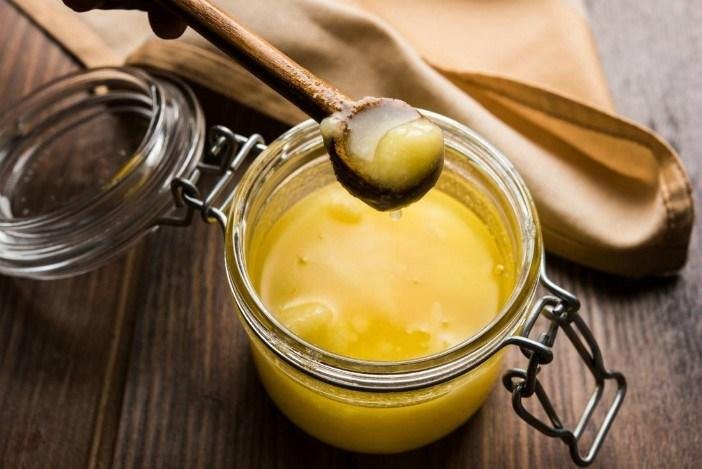Ghee: The Superfood of India

Ghee (clarified butter) is a hero ingredient known for making everyday meals delicious. Besides tasting great, this cooking fat also offers multiple health benefits, particularly for your heart.
Ghee or clarified butter is a preferred cooking staple in most Indian kitchens. Ayurveda uses ghee in several therapeutic preparations.
Also known as ghrta or ghrita in Sanskrit, ghee is said to be the healthiest all-natural source of edible fat. Ayurveda claims that it promotes longevity and immunity.
With 60-70% saturated fats and0% preservatives, cow ghee can protect your heart health. It is also known as Medha Rasayana or brain tonic. Recent rat studies reveal that ghee boosts memory, learning, and recall in adults and children.
Consuming optimal amounts of ghee preserves the health of your heart and brain. It may also aid weight loss and wound healing.
Talking of the wide range of benefits, Ghee:
1. Has Cardioprotective Properties
In recent years, ghee has been linked to cardiovascular diseases. But research offers a contradicting view. As part of an elaborate study, rats were fed 10% dietary ghee for 4 weeks.
It did not show any effect on the serum lipid profiles and liver health of the rats.
In fact, other animal studies exhibited a decrease in serum cholesterol levels – particularly the LDL and VLDL levels.
Another study was carried out on men from rural India. It revealed a significantly lower prevalence of coronary heart disease, especially in men who were consuming high amounts of ghee. Ghee contains a variety of fats that can help provide a healthy boost to the heart.
2. Aids Weight Loss
Since ghee is about 60% saturated fats, it is often linked to weight gain. Researchers conducted multiple animal experiments to understand how this works. Most of these studies reported contradictory results.
In rat studies, several subjects were fed ghee, butter, and a commercial drug. The rats that were fed cow ghee showed a decrease in body weight that was comparable to the drug standard.
This weight loss may be because ghee aids faster digestion and absorption of food. Ghee stimulates the secretion of stomach acids to aid digestion, unlike other oils that slow down the digestive process.
3. May Improve Memory and Brain Health
Known to be brain tonic in Ayurveda, its high saturated fat content makes it less desirable.
Cow ghee contains fair amounts of polyunsaturated fatty acids (PUFA). It also contains omega-3 fatty acids like eicosapentaenoic acid (EPA), docosahexaenoic acid (DHA), cholesterol, and linolenic acid. These fatty acids play a significant role in preventing dementia and neurodegenerative diseases.
High amounts of DHA are found in the cerebral cortex. Also, your brain has>2% (by weight) of cholesterol, thus explaining its role in proper functioning. Sufficient doses of ghee, thus, may impact smooth brain signaling, mental alertness, and memory.
4. May Prevent Cancer
The initial stages of cancer development (carcinogenesis) happen at the lipid membranes of various cells. When suitable enzymes react with the carcinogenic (cancer-causing agent) molecules, they trigger tumour development.
Carcinogenesis can be prevented by altering the composition of the membrane lipids. Ghee contains saturated and monounsaturated fats that can modify the chemistry of these lipids.
As ghee is a dairy product, it contains conjugated linoleic acid (CLA). CLA is a documented anticarcinogenic agent. Animal studies too support the antitumor effects of ghee in cancers of colon, breast, and liver compared to other cooking fats.
5. May Maintain Cholesterol Levels
Unlike butter, ghee has the right mix of long and short saturated fatty acids. This composition makes it easier to digest ghee. It also has relatively higher polyunsaturated fatty acid (PUFA) content than butter-like fats.
PUFAs help in the efficient excretion of cholesterol. This, in turn, prevents cholesterol accumulation and peroxidation that cause heart diseases.
The presence of conjugated linoleic acid (CLA) in ghee also exerts a tight control on your lipid levels. As low as 0.5% of CLA has been found to reduce total triglycerides by 28%! Having ghee may not increase HDL levels but it can prevent the accumulation of cholesterol, thus balancing the serum lipid profile.
6. Heals Wounds and Inflammatory Scars
Ghee is used as an ointment base in several Ayurvedic preparations. In combination with honey, it is useful in treating wounds, swelling, burns, and blisters.
Ghee can regulate the production of prostaglandins (compounds that increase inflammation) with the help of its abundant essential fatty acid content. By controlling the secretion of such molecules, ghee improves the rate of healing and recovery.
This cooking fat can also relieve chronic pain from haemorrhoids. Apply a combination of cow ghee and Shorea robusta resin in the rectal prolapse. It may reduce the burning sensation and excess secretion.
The butyrate in ghee can help in reducing inflammation in the digestive tract and body.
7. Boosts Digestion
Ayurveda claims that ghee is easy to digest. It is light on your tummy, unlike other cooking oils. Cow ghee lubricates the digestive tract and enhances digestion without irritating the stomach.
It also balances the gastric acid secretion in your gut. This way, the inner mucosal layer of the stomach remains protected. It also cleanses the colon, which indirectly frees your bowel movement.
Pregnant women are advised to have meals cooked in milk and ghee to prevent constipation, nausea, and vomiting in the early months. In later months, regulated servings of ghee may promote foetal development.
8. Hydrates and Repairs Your Skin
Ghee is said to be effective in treating skin rashes, allergies, and dryness. It is rich in essential fatty acids. Deficiency of these omega-3 and omega-6 fatty acids manifests as toad skin (phrynoderma) and horny eruptions on the limbs.
Consuming ghee or topically applying it improves the moisture-holding capacity of your skin. Massaging it into your skin stimulates the production of endorphins. Endorphins enhance your immunity. Following a routine of ghee-massaging and bathing has shown to slow down the process of aging.
Using different preparations of ghee with milk and lentils on your face may improve your complexion. Applying a ghee-based foot pack with bee wax, potassium and sodium salts can soften cracked heels and rough soles.
It is, hence, proven that having ghee is good for your health. The saturated fats and cholesterol content of this ingredient are more helpful than harmful.
Nutrition Profile of Ghee
Since ghee has almost no trans-fat, it can be used for cooking. It is also a good idea to have a bottle of ghee on hand as it serves as an excellent topical therapeutic agent.
Making ghee at home is worth all the time you invest in it. The final product is pure and free of almost all contaminants. Here’s how you can do it.
What You Need:
- Cream or fat from (preferably high fat) milk: around 1 kg
- Storage glass jars
- Yogurt: small amount (as starter culture)
- Churning rod or suitable setup
- Heating pan or microwave
- Muslin cloth (or equivalent): to filter
1. Add 2 teaspoons of yogurt to a medium or large-sized container (that can fit 1 kg of cream).
2. Collect the cream or fat layer in this container from high-fat or regular milk for about 8-9 days. Keep the container in the refrigerator during this period as cream turns bad quickly.
3. After you have collected enough cream, you need to start churning it. Use a churner for this step.
4. Add 2-3 tablespoons of cold water. Churn for 3-4 minutes.
5. Keep adding water to separate the ‘buttermilk’ from the mixture.
6. After 8-10 minutes of churning, you will notice bubbles of butter at the top separating from the liquid part.
7. Collect this layer of butter in another container.
8. Add this extracted butter to a deep utensil and let it melt on low heat.
9. Stir the mixture properly when the fat starts to melt. Cook on low flame for about 18-20 minutes. The bubbles/foam will start to settle, and the mixture will turn into a golden liquid.
10. Scoop this liquid (or crude ghee) into a clean container.
11. Boil this crude ghee on high heat for 3-4 minutes. You will see the milk granules charring at the bottom of the vessel.
12. Turn off the heat. Let the ghee cool down for another 10 minutes.
13. Filter the ghee from the dark brown milk granules into a clean container.
How to Store Ghee
Store ghee in a clean, well-finished glass jar. Keep the jar in a cool and dark place for long-term storage. One doesn’t need to refrigerate ghee even after opening a jar.
But, if it is in use for over 3 months, storing it in the fridge will extend its shelf life.
Ideally, you should finish home-made ghee within a year. Beyond that, you may need to keep doing a smell-and-look test every week.
The best way out is to prepare small batches of ghee at a time.
If that is not feasible, make a big batch and store the filtered ghee in multiple small jars. Pick jars that can hold a month’s serving size.
You can store the rest in the fridge or outside, depending on your room temperature.
Any Side Effects of Having Ghee Regularly?
Although it is claimed that ghee increases the risk of cardiovascular diseases, the scientific literature does not agree entirely with the statement.
Animal studies prove that ghee when it constitutes up to 10% of your diet, does not have any adverse effects. In fact, at this dose, ghee exhibits protective effects on the vital organs. The lipid profiles also remained unchanged in rat subjects at this dose.
Compared to other cooking oils (that are rich in SFAs), ghee is probably the least harmful.
If you are looking for a recommended dietary intake limit for ghee, you may not find one because a set range or limit has not been established yet.
However, the American Heart Association recommends limiting the consumption of saturated fats to less than 7% of energy intake.
The Indian Council of Medical Research (ICMR) states that about 25–30% of calories should come from fat. Some invisible fats (about 25-30 g/day) are consumed through staple foods and nuts.
This leaves you with only 15-20 g of fats. Therefore, just 3-4 teaspoons of cooking oil/fat should be consumed daily.
Having a spoonful of raw ghee on an empty stomach is considered to be the most effective way. Although Ayurveda vouches for this, it is not backed by scientific evidence yet.
Instead, you can add ghee to your breakfast – on your toast, with salad, or in oatmeal. Replacing salted/unsalted butter with ghee works well.
Summarizing, not many of us can adhere to the set limits of oil intake. The least we can do is to choose oils/fats that have minimal adverse effects. Ghee is the best choice in such cases.
Ghee offers purity, taste, and health and is devoid of impurities. Switching to ghee can make your meals healthy and you- strong!















































